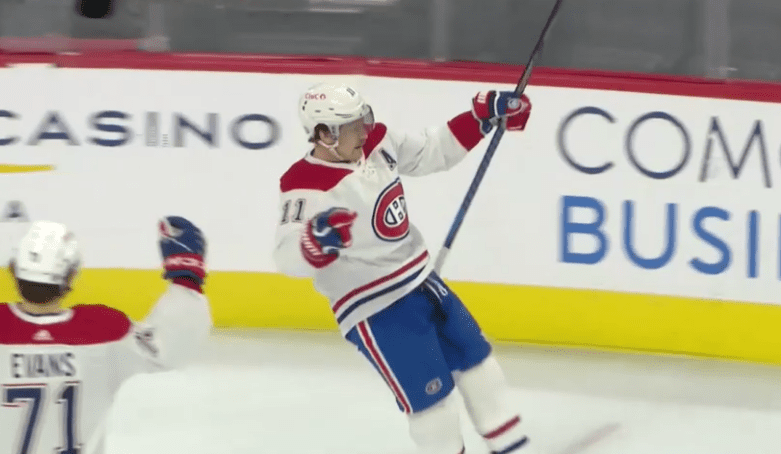Canadiens Analysis
Remaining Canadiens Bergevin Contracts An Issue For Hughes

A quick look at the Montreal Canadiens roster confirms Kent Hughes has done a reasonably good job removing inflated contracts from the organization.
Since taking over as general manager, Hughes has found a new home for players like Ben Chiarot, Joel Edmundson, Jeff Petry, and Mike Hoffman.
The returns varied, with Chiarot leading to a first-round pick from the Florida Panthers, whereas Petry’s final trade led to little to no returns in terms of asset value.
But that was the easy part.
Now Hughes is tasked with removing the last vestiges of the former administration, a rather tricky proposal seeing as Marc Bergevin added too much term to the deals he signed in his final years as general manager.
Two Years Left
As it stands, there are four contracts offered by Bergevin on the books that will extend into 2024-25.
You can easily argue that Jake Evans’ deal shouldn’t be considered a pressing issue, though $1.7 million is a little expensive for a fourth-line centre. However, he has maintained a reasonable production level despite being used in a situation that is not conducive to scoring. He only accounts for two percent of the total salary cap expenditures this season, and since the salary cap is expected to go up next season, he’ll account for even less.
The real problem arises when discussing players such as Christian Dvorak and Joel Armia. Both have two years left on their deals, which pay them $4.45 million and $3.4 million per year, respectively. Dvorak’s contract wasn’t actually a Bergevin deal, but considering he paid a first and second-round pick to acquire the underwhelming forward, he’s clearly to blame for adding yet another inflated contract to the books.
Dvorak’s $4.45 annual average value (AAV) will limit the options, as will his recent streak of injuries, but there is still some value to be found in his play. Granted, his underlying numbers have been disastrous in Montreal, but he can still produce a certain level of offence if used on a team that isn’t constantly getting caved in from a defensive standpoint. He’s also a centre, which can often become a hot commodity in the trade market.
But there’s also another hurdle.
Dvorak has a modified no-trade clause, which allows him to submit an eight-team no-trade list. That may not seem like a lot, but when you already have an asset that’s damaged goods, removing almost 30 percent of the teams in the league as trade destinations will certainly limit the options.
Fortunately, Armia was not given a no-trade or no-movement clause, but at this point, it doesn’t really matter. His contract, injury issues and overall production will act as a no-trade clause for most teams in the league.
Fans who want to see both players moved will have to be patient seeing as the outlook for potential trades is poor, to say the least, especially now that the Montreal Canadiens have already used two of their three salary retention slots.
There’s potential for a trade involving David Savard, though any team that listens to their data science department (analytics) will surely scoff at the prospect of acquiring a 32-year-old defenceman who produces some of the worst stats in the league.
Long Term Outlook
Every time the Montreal Canadiens pay Carey Price’s yearly bonus, the odds of Hughes being able to move his contract improve, especially when discussing a cash-strapped team that tends to acquire bad contracts for little to no return. I’ll let you figure out exactly which Western Conference team that plays in the desert that I’m referring to.
Moving Price would allow Hughes a little more financial maneuverability, seeing as the team would no longer have to put his contract on the long-term injured reserve, thus restricting their options. But, for now, the Canadiens are likely stuck with Price’s contract for at least another year.
This leads us to another player who was once considered the heart and soul of the team: Brendan Gallagher.
Much like Josh Anderson, Gallagher has another four years left on his contract, but unlike Anderson, very few teams are calling to ask about acquiring the forward.
At $6.5 million per season until 2026-27, Gallagher’s contract presents a significant issue for the Montreal Canadiens, which is a little unfortunate given that for many years Gallagher was one of the best-value players in the entire NHL.
Gallagher is the epitome of a hard-working player, and no one will ever suggest that he wasn’t a crucial part of the roster for the better part of a decade, but the unfortunate reality is that the NHL is a business, and sometimes harsh decisions must be made.
On top of making too much for too long, Gallagher was also given a no-move clause, as well as a no-trade clause (six-team list), which means that the team will have to work in conjunction with Gallagher if a deal is to occur.
The good news is that Gallagher’s numbers surged last season when he finally played a few games with optimal health. The bad news is that I’ve written that exact same sentence several times over the years, and after several unfortunate hand injuries, it seems like most of Gallagher’s scoring prowess has fallen to the wayside.
Even if most fans want to see the Armia and Dvorak deals off the books, they should be more worried about the declining player that takes up over 7 percent of the salary cap and is unlikely to garner any interest around the league for the next four years.









